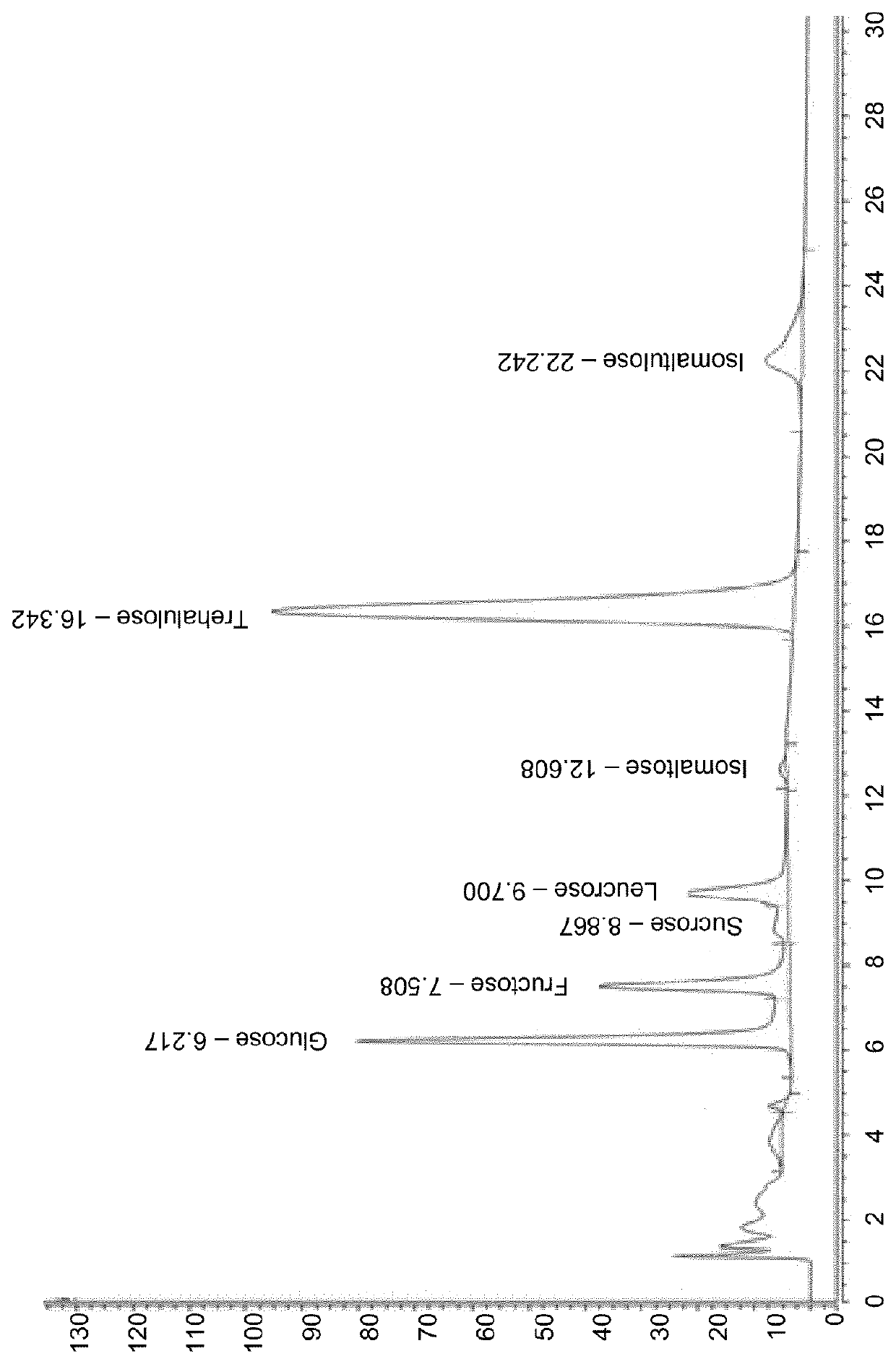Sucrose isomerases as food and nutritional supplements
a technology of sucrose isomerase and nutritional supplement, which is applied in the direction of enzymology, peptide/protein ingredients, transferases, etc., can solve the problems of reducing the sugar content, affecting the mouth feel and indulgence, and sucrose replacements are not used frequently
- Summary
- Abstract
- Description
- Claims
- Application Information
AI Technical Summary
Benefits of technology
Problems solved by technology
Method used
Image
Examples
example 1
[0062]Sucrose Isomerases
[0063]Six proteins annotated as sucrose isomerases were selected from the Uniprot data base. The sequences originated from Protaminobacter rubrum (Uniprot:D0VX20), Pantoea dispersa (Uniprot:Q6XNK6), Raoultella planticola (Uniprot:Q6XKX6), Pseudomonas mesoacidophila (Uniprot:Q2PS28), Enterobacter (Uniprot:B5ABD8), and Pectobacterium carotovorum (Uniprot:S5YEW8). Putative signal peptides were predicted by SignalP 4.1 prediction software for gram negatives (Petersen, Nature Methods, 8:785-786, 2011). When present these signal peptides were replaced with a Methionine (M) and this resulted in the protein sequences depicted in SEQ ID NO:1-6.
[0064]The protein sequences (SEQ ID NO:1-6) were expressed in E. coli as described in WO2017050652 (A1). Synthetic DNA sequences encoding the putative sucrose isomerases were codon optimized for expression in E. coli according to the algorithm of DNA2.0 (GeneGPS® technology). For cloning purposes, DNA sequences containing a NdeI...
example 2
Activity of Sucrose Isomerases at Different pH
[0075]To test the activity of the different sucrose isomerases on sucrose at different pH, we incubated a 20% sucrose / 250 mM sodium phosphate buffer with the different enzymes at 10% dilution (0.07-0.21 mg protein / ml). pH of the solution was set at either 4.5 and 6.0, and the incubation was for 6 hours at 37° C., after which the reaction was stopped by heating at 99° C. for 5 minutes. Conversion of sucrose into different sugars was quantified using the Dionex HPLC method. Results are depicted below in Table 3 as average percentage of the total amount of all sugars detected in the samples after the incubation, obtained from experiments with 2-4 different preparations of the respective enzymes.
TABLE 3Conversion of sucrose into various sugars at various pHs using sucrose isomerasesFruc-Glu-Isomaltu-Isomal-Leu-Trehalu-SucrosetosecoselosetosecroseloseAvg %pH 4.5Sis1011817375121Sis201620493112Sis12424641126Sis40914220946Sis14103630033Sis150143...
example 3
Activity of Glucan Sucrases at Different pH
[0077]To test the activity of the different glucan sucrases on sucrose at different pH, we incubated a 20% sucrose / 250 mM sodium phosphate buffer with the different enzymes at 10% dilution. pH of the solution was set at either 4.5 and 6.0, and the incubation was for 6 hours at 37° C., after which the reaction was stopped by heating at 99° C. for 5 minutes. Sugar composition was quantified using the Dionex HPLC method. Results are depicted below in Table 4 as the percentage of total sugar after the conversion, obtained from experiments with the respective enzymes. Since glucan can exist of different forms, it is difficult to quantify using the HPLC method used in these experiments. Therefore, the total formation of glucan was calculated from the difference in the increase in fructose and glucose, after correction for the fructose and glucose content of the blanc without added enzyme. Therefore, the numbers indicated are only a rough estimate...
PUM
| Property | Measurement | Unit |
|---|---|---|
| weight | aaaaa | aaaaa |
| volume | aaaaa | aaaaa |
| pH | aaaaa | aaaaa |
Abstract
Description
Claims
Application Information
 Login to View More
Login to View More - R&D
- Intellectual Property
- Life Sciences
- Materials
- Tech Scout
- Unparalleled Data Quality
- Higher Quality Content
- 60% Fewer Hallucinations
Browse by: Latest US Patents, China's latest patents, Technical Efficacy Thesaurus, Application Domain, Technology Topic, Popular Technical Reports.
© 2025 PatSnap. All rights reserved.Legal|Privacy policy|Modern Slavery Act Transparency Statement|Sitemap|About US| Contact US: help@patsnap.com

